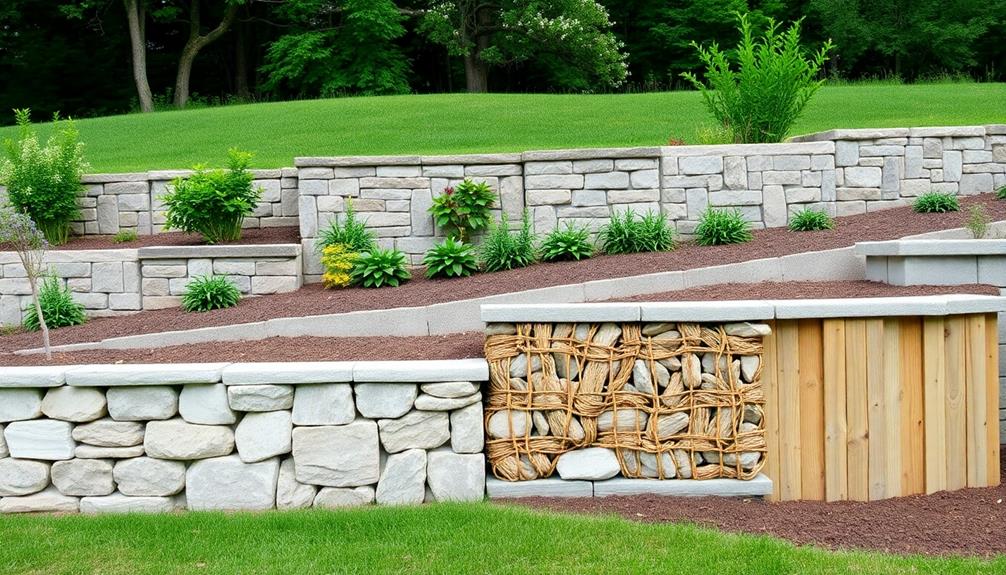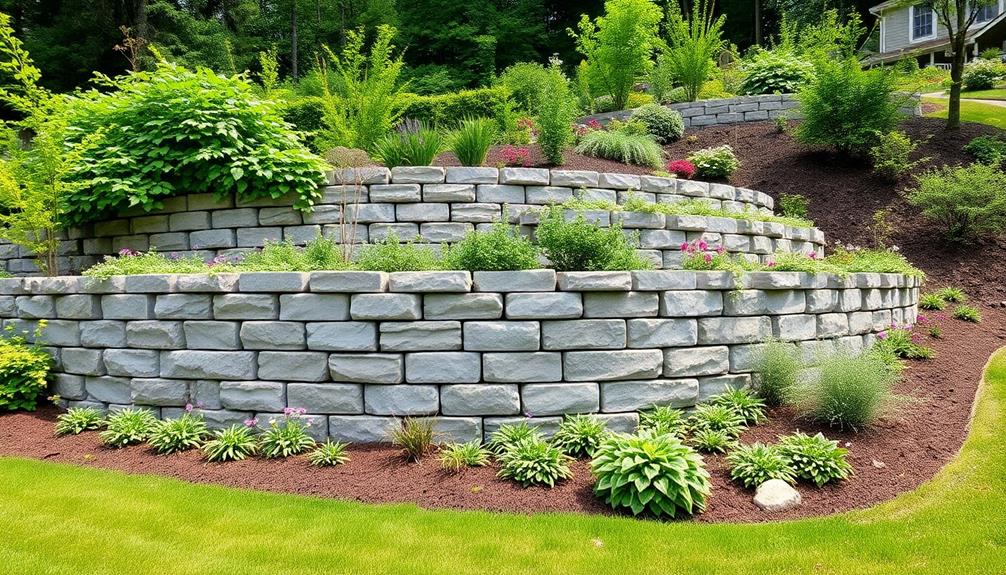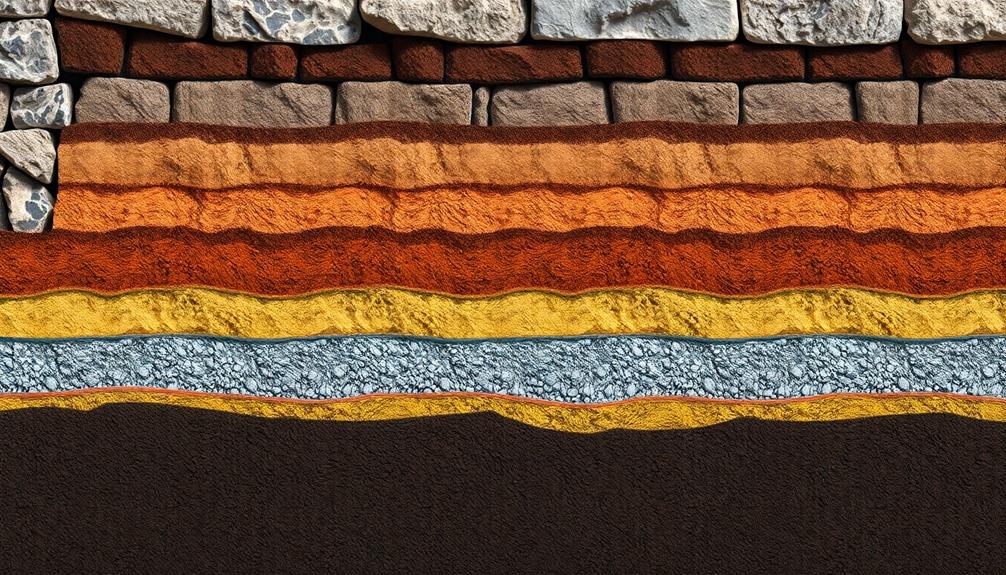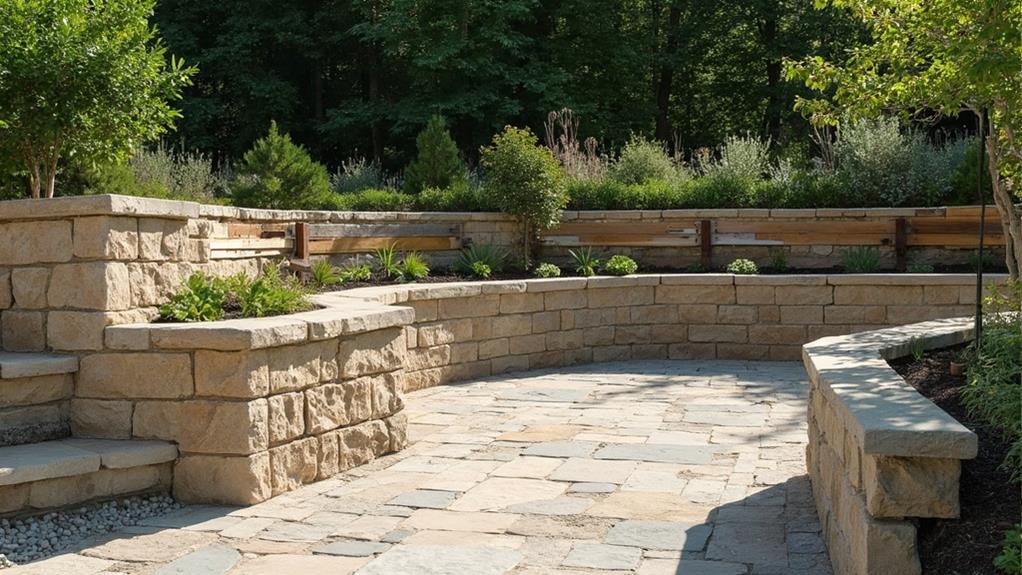Retaining walls are essential in landscaping, transforming sloped terrains into stable, usable spaces while preventing erosion. Selecting the best materials for these structures involves evaluating concrete for its strength and versatility; natural stone for its aesthetic appeal and timeless elegance; timber, which offers rustic charm at a lower cost; brick for its classic durability; and manufactured blocks known for ease of installation and uniformity. Each material provides unique benefits such as structural stability, erosion control, and aesthetic enhancements, contributing greatly to both the visual and functional value of outdoor spaces. Moreover, advanced materials offer enhanced resilience and sustainability.
Table of Contents
ToggleWalls Contractor Highlights
- Concrete offers strength, versatility, and can be molded into various shapes for retaining walls.
- Natural stone provides aesthetic appeal and timeless elegance, though it is more expensive.
- Timber is cost-effective, ideal for budget projects, with rustic charm.
- Manufactured blocks are easy to install with an interlocking design for uniformity and strength.
- Geosynthetics like geogrids reinforce soil and enhance overall wall stability.
What Is a Retaining Wall

A retaining wall serves a vital purpose in landscaping by holding back soil and preventing erosion, allowing for the creation of level areas on uneven terrain and improving the functionality of outdoor spaces. Constructed from an array of materials such as concrete, stone, timber, and brick, each option offers unique benefits and characteristics suited to various structural and aesthetic requirements.
For example, incorporating boulder walls can enhance the aesthetic appeal and provide customizable dimensions for large walkways. Understanding the role of retaining walls is essential in both residential and commercial landscaping, as they contribute tremendously to both the stability and the visual appeal of a property.
Purpose and Functionality
Retaining walls are essential structures in landscaping and construction, serving the critical function of holding back soil and preventing erosion. These walls play a pivotal role in creating level areas within sloped landscapes, providing stability and enhancing both the aesthetics and utility of outdoor spaces. By resisting the lateral pressure of soil, retaining walls prevent land displacement, which is particularly indispensable in terrains prone to erosion or where existing landscapes need to be preserved.
In urban and suburban environments, retaining walls contribute to the efficient use of available land by transforming uneven areas into functional spaces for gardens, walkways, or terraces. Their design integrates engineering principles that guarantee long-term stability and effectiveness, while also supporting drainage management—channeling water away from slopes to prevent soil saturation and subsequent instability.
This dual role in aesthetics and functionality helps them harmonize with surrounding structures, promoting a sense of cohesion and belonging. Moreover, retaining walls enable homeowners and developers to customize their landscapes, enhancing property value and utility, while protecting investments against the relentless forces of nature. As a result, they are a cornerstone of landscape architecture and construction, underpinning projects with both functional stability and enhanced aesthetic appeal.
Common Construction Materials
Several key materials are commonly employed in the construction of retaining walls, each offering distinct advantages with respect to durability, appearance, and cost. Concrete, one of the most prevalent choices, is celebrated for its strength and versatility. It can be molded into various shapes and can include steel reinforcement for added robustness, making it suitable for both residential and commercial applications.
Alongside concrete, natural stone offers an aesthetic appeal and timeless elegance. Despite being more expensive, its unique textures and colors provide an enhancing visual quality that appeals to those seeking an integration with natural surroundings.
Conversely, timber is preferred for projects with budget restrictions. Timber walls, typically constructed from treated wood to prevent decay, are easy to install and lend a rustic charm. However, they require more upkeep than other materials.
In addition, brick remains a favored option for its classical beauty and durability. Its longevity and low maintenance make it a cost-effective option over time.
Manufactured blocks also present a modern solution, offering ease of installation and uniformity. Their interlocking design reduces the need for mortar, ensuring efficient assembly. By opting for these materials, individuals can achieve a harmonious blend of functionality and visual appeal.
Importance in Landscaping
Understanding the materials used in retaining wall construction provides a foundation for appreciating their role in landscaping. Retaining walls are structural elements that transform uneven or sloped terrains into functional, aesthetically pleasing spaces. They enable the stability and sustainability of landscapes by preventing soil erosion and managing water runoff, essential for preserving both the environment and property value. By integrating design and functionality, retaining walls contribute to the coherence and unity of outdoor spaces, which fosters an immediate sense of belonging for people interacting with these areas.
In the context of landscaping, the importance of retaining walls extends to their ability to create visually distinct zones, allowing homeowners and communities to utilize outdoor spaces more effectively. They not only facilitate the integration of gardens, terraces, and walkways but also enhance physical accessibility across various levels of elevation. This transformation of landscapes into welcoming and usable environments speaks directly to an audience that prioritizes connection with nature and shared community spaces. Mastery of retaining wall construction and material selection is key to achieving a landscape design that feels inclusive and harmonious, ensuring that these structures become more than just functional necessities, but integral parts of the environmental and social fabric.
Benefits

The strategic use of retaining wall materials offers significant advantages, primarily in mitigating erosion while enhancing structural integrity. These materials can also create usable spaces for gardening, patios, or parking pads, adding functional and aesthetic value to any property. With an array of aesthetic design options available, these walls not only serve a functional purpose but also contribute to the visual appeal of landscapes.
Additionally, their capacity for long-term cost efficiency makes them a prudent investment for projects seeking durability and sustainability.
Enhanced Erosion Control
Utilizing advanced materials for retaining walls can drastically bolster erosion control, offering notable benefits for both residential and commercial landscapes. In the face of relentless elements, enhanced erosion control is critical to maintaining the integrity of a space, as erosion can compromise soil stability, leading to landscape degradation. With innovative materials such as geotextiles and modular interlocking concrete blocks, retaining walls can better resist soil displacement, consequently protecting properties from the detrimental impacts of erosion. These cutting-edge solutions not only aim to withstand natural forces but also contribute to the longevity and sustainability of landscaping designs.
Moreover, the utilization of such sophisticated materials promotes harmony between the built environment and its natural surroundings, fostering a sense of belonging within the ecosystem. By incorporating these materials into your retaining walls, erosion control is executed with enhanced efficiency, reducing potential repair and maintenance costs. The thoughtful integration of advanced materials affirms the commitment to preserving ecological balance while embracing modern building techniques. Ultimately, sophisticated erosion control measures enabled through these materials result in landscapes that are not only aesthetically pleasing but also environmentally sound, resonating with communities that value resilience and sustainability.
Improved Structural Stability
Strengthening your retaining wall with cutting-edge materials can enormously enhance its structural stability, providing numerous benefits for both safety and longevity. By adopting modern materials such as reinforced concrete, modular block systems, or geosynthetics, the structural integrity of retaining walls is substantially improved. Reinforced concrete adds immense tensile strength, allowing walls to withstand significant loads, while modular block systems ingeniously interlock, offering enhanced flexibility and resistance to environmental pressures.
Geosynthetics, such as geogrids, reinforce the soil, improving cohesion and adding resilience to the structure. These advanced materials often withstand the test of time, reducing the incidence of failures related to shifting or hydrostatic pressure that can compromise traditional retaining structures. Implementing high-strength materials not only mitigates the risk of collapse but also minimizes maintenance requirements, translating to long-term cost savings.
For communities, this stability fosters a sense of safety and confidence, knowing that their environment is constructed with enduring reliability in mind. Utilizing advanced materials further offers an opportunity for sustainable development, often made from recycled materials which contribute positively toward eco-friendly construction initiatives. Ultimately, the conscientious choice of materials fortifies retaining walls against the challenges of natural forces, ensuring stability and security for the future.
Aesthetic Design Options
Integrating aesthetic design options into retaining wall construction not only enhances visual appeal but also elevates the overall landscape architecture. By incorporating diverse materials such as natural stone, wood, and textured concrete, homeowners and designers can achieve a harmonious blend that reflects individual tastes and environmental cohesion. These materials offer myriad design possibilities, from rustic, natural appearances to sleek, modern lines, ensuring that retaining walls serve as striking focal points rather than mere functional structures.
The versatility in materials allows for customized patterns, colors, and finishes, fostering a sense of individuality and belonging among community members who appreciate nuanced, carefully crafted environments. Additionally, these aesthetic enhancements can greatly contribute to the perceived value of a property, which reinforces the intrinsic connection between beauty and worth. This not only satisfies personal desires but further nurtures a collective pride in shared spaces.
Furthermore, aesthetic considerations encourage innovative use of space, where retaining walls can integrate features such as seating or planters, seamlessly melding utility with elegance. Such thoughtful designs enrich day-to-day living, while simultaneously fostering an inviting atmosphere. Ultimately, aesthetic options in retaining walls serve as a bridge between functionality and art, fostering a sense of community through engaging yet practical design.
Long-Term Cost Efficiency
Achieving long-term cost efficiency in retaining wall construction is a significant consideration for both homeowners and developers. The choice of material plays a vital role in sustainability and financial prudence over the years.
Durability and Maintenance: Materials like concrete and stone offer exceptional durability, reducing the frequency of repairs and thereby decreasing maintenance expenses over time. This resilience translates into stability and continuity for projects.
Initial Investment versus Long-Term Savings: Although premium materials such as natural stone may have a higher upfront cost, their longevity often results in substantial savings over the lifespan of the wall, outweighing initial expenditures.
Energy Efficiency: Certain retaining wall materials contribute to the insulation of the surrounding area, minimizing the need for additional energy consumption, which results in long-term financial benefits.
Environmental Impact: Selecting eco-friendly materials not only supports sustainability but also potentially qualifies the project for green incentives, further enhancing its economic efficiency.
Types of Soil Considerations

Understanding the types of soil and their specific properties is pivotal when constructing retaining walls, as the characteristics of the soil meaningfully impact the effectiveness and durability of the structure. Soil drainage, texture, and stability are key considerations, each affecting how a retaining wall interacts with its environment to manage water flow and structural load. The table below outlines these considerations and their implications for wall design:
| Soil Consideration | Importance | Implication on Design |
|---|---|---|
| Soil Drainage | Prevents water buildup | Requires efficient drainage systems |
| Soil Texture Variations | Influence load distribution | Affects choice of wall material |
| Soil Stability Factors | Ensures structural integrity | Determines wall height and type |
Soil Drainage Importance
Proper soil drainage is essential when constructing retaining walls, as it directly impacts the wall's stability and longevity. Without adequate drainage, accumulated water can exert hydraulic pressure on the wall, leading to structural failures and potential collapse. Considering the soil's capacity to drain is crucial in the planning stages, allowing for adjustments that ensure durability and safety.
Implementing proper drainage solutions involves understanding and integrating several key considerations. Here are four fundamental elements to evaluate:
- Site Assessment: A thorough evaluation of the project's location, including topography and potential water flow paths, is the first step to identifying drainage needs and solutions.
- Material Selection: Selecting permeable materials, such as gravel or sand behind the wall, helps facilitate efficient water movement away from the structure, reducing hydrostatic pressure.
- Drainage Systems: Installing effective drainage systems, such as weep holes or perforated pipes, will further assist in managing water levels, ensuring the integrity and longevity of the wall.
- Maintenance Plans: Regular inspection and maintenance of drainage features are vital to prevent blockages and to ensure that the drainage system continues to function optimally over time.
Emphasizing these aspects creates a sense of unity among engineers, builders, and property owners in preventing structural issues.
Soil Texture Variations
Building on the importance of soil drainage, considering soil texture variations becomes equally significant when planning for retaining walls. Different soil textures, such as clay, silt, sand, and loam, play essential roles in how a retaining wall responds to environmental stressors and weight loads. Each type possesses distinct properties in the context of particle size, compaction capacity, and permeability, which impact the structural integrity of the wall.
Clay soils, characterized by fine particles and high plasticity, retain considerable moisture, posing potential challenges due to their tendency to swell and shrink. This requires careful attention to drainage to mitigate hydrostatic pressure against the wall. Conversely, sandy soils with larger particles offer excellent drainage, but lack cohesion, which may lead to instability if not adequately compacted.
Loam, a preferred mixture of sand, silt, and clay, provides a balanced texture that supports both drainage and stability, making it a suitable choice for many engineering projects. Understanding the inherent qualities of these textures allows for informed decisions regarding wall materials, construction methods, and necessary reinforcements. As a result, aligning with the natural landscape, we facilitate both functional and enduring retaining wall solutions tailored to our specific environments.
Soil Stability Factors
In evaluating soil stability factors essential for retaining wall projects, a thorough examination of soil considerations is indispensable. Soil strength and its interaction with water, construction materials, and environmental conditions are pivotal in designing stable retaining walls.
To guarantee robust construction, it is critical to assess the following characteristics:
- Soil Type and Composition: The inherent properties of various soils, such as clay, silt, or sand, directly impact the stability of retaining walls. Clay, for instance, offers greater cohesiveness but may swell with moisture, whereas sand is more prone to erosion.
- Moisture Content: The presence of water remarkably affects soil stability. High moisture content can weaken soil structure, reduce bearing capacity, and induce potential wall failure due to increased lateral earth pressure.
- Density and Compaction: Well-compacted soils enhance the stability of retaining walls by increasing density and reducing void spaces, minimizing shifting or settling over time.
- Angle of Internal Friction: This parameter describes the soil's natural resistance to sliding along internal planes, thereby influencing the wall's ability to withstand lateral pressures without collapse.
For communities with shared projects or those seeking quality infrastructure, considering these factors fosters confidence in the safety and durability of retaining structures, promoting a sense of unity and trust in collective endeavors.
Walls Contractor FAQ
What Are the Most Durable Materials for Retaining Walls?
The most durable materials for retaining walls include concrete, natural stone, and reinforced masonry. These materials provide excellent stability and longevity, ensuring structural soundness and aesthetic appeal, thereby fostering a sense of security and connection within the built environment.
How Does Weather Impact the Choice of Retaining Wall Materials?
Weather markedly influences the selection of retaining wall materials, as factors like temperature fluctuations, precipitation, and freeze-thaw cycles impact durability. Choosing materials resilient to environmental conditions guarantees structural integrity and fosters a sense of security in community infrastructure.
What Is the Cost Comparison for Different Retaining Wall Materials?
The cost of retaining wall materials varies enormously. Concrete blocks are often cost-effective, while natural stone incurs higher expenses. Timber can be economical, though longevity and maintenance impact value. Comparing initial and lifecycle costs is pivotal.
Are There Eco-Friendly Options for Retaining Wall Materials?
The quest for eco-friendly retaining wall materials has gained momentum. Options such as recycled concrete, sustainably sourced wood, and living walls offer environmentally responsible solutions, fostering a sense of community commitment to sustainability and ecological preservation.
How Do Maintenance Needs Vary Among Retaining Wall Materials?
Maintenance requirements vary considerably across retaining wall materials. Concrete demands minimal upkeep, while wood is susceptible to rot, necessitating regular treatment. Stone offers durability with limited maintenance, and gabions require occasional inspections to guarantee wire integrity.







